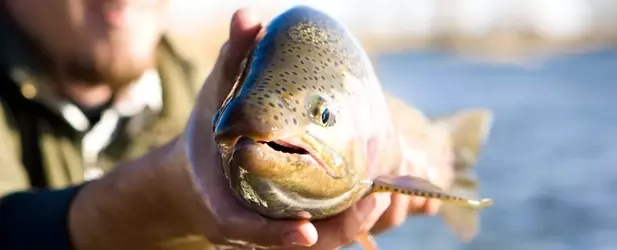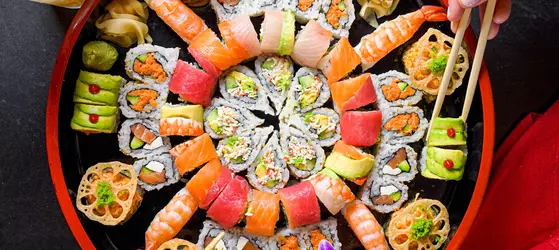https://www.sciencealert.com/fish-suffer-up-to-22-minutes-of-intense-pain-when-taken-out-of-water
https://archive.ph/jB5Gf

Each year, a trillion or so fish are pulled from the water, typically destined for our plates. While it's hardly a pleasurable outcome for the animal, a new study has just put a sobering number on their suffering.
Rainbow trout (Oncorhynchus mykiss) hail originally from the Pacific Ocean's cold water tributaries, but are now a popular food fish worldwide, farmed in every continent except Antarctica.
Most of the time they are killed by asphyxiation, either in open air or ice water. While this is a cost-effective way to kill fish en-mass, an international team of biologists, led by Cynthia Schuck-Paim from the Welfare Footprint Institute, has found that each fish can experience up to 22 minutes of intense pain with this method.
Animal suffering is a difficult thing to quantify, but scientists have recently developed a standardized framework that factors in the intensity of negative states like stress or pain and the length of time they're experienced.
It's called the Welfare Footprint Framework, or WFF. The hope is that it will allow people who work with animals – biologists, veterinarians, zookeepers, farmers, etc – to compare and improve animal welfare standards.
"Societal concern about the impacts of production practices on animal welfare is rising, as evidenced by consumer-driven movements, labelling efforts, accreditation schemes, policies and legislation that prioritize animal welfare," the study's authors write.
"Our findings provide the first quantitative estimates of pain during fish slaughter, demonstrating the potential scale of welfare improvements achievable through effective stunning methods."

Sifting through stacks of published scientific papers, the team created a detailed picture of the experience of a fish out of water.
Just five seconds of air exposure triggers a neurochemical response we might associate with negative emotions in ourselves. Behaviors such as vigorous twisting and turning further demonstrate an intense aversion reaction.
Without water, the delicate gill structures that exchange oxygen for carbon dioxide stick together, causing CO2 from respiration to accumulate. These rising levels trigger nociception – the body's alarm system – which causes the fish to gasp. Eventually the elevated CO2 levels acidify the animal's blood and cerebrospinal fluid, ultimately resulting in unconsciousness.
Depending on the size of the fish, and the conditions in which it is slaughtered, these distressing experiences can last anywhere between 2 and 25 minutes.
"When standardized by production output, this corresponds to an average of 24 minutes per kilogram, with over one hour of moderate to extreme pain per kilogram in some cases," the authors note.
They estimate that electrical stunning, which has been proposed as a humane alternative for killing fish, could save up to 20 hours of moderate to extreme pain per US dollar of capital expenditure.
But brain scans have found the effectiveness of electrical stunning can vary widely: ideally, the animal should be rendered immediately and wholly unconscious until death. With current stunning methods, this isn't always the case.
"The welfare impact and effectiveness of any stunning method also depends critically on the entire harvest process, being affected by cumulative pre-slaughter stressors," Schuck-Paim and colleagues write.
"The WFF can also be used for assessing the welfare impacts of these processes and identifying priority areas for effective intervention."
While it's difficult for many of us to confront the cost of our human activities from an animal's perspective, this comparable measure of animal experience offers a clear picture of where improvements can be made for the welfare of our food stocks.
By quantifying the pain associated with this most common fish slaughter method, we may find better ways to care for the billions of animals that feed us each year.
The research is published in Scientific Reports.

Edit: I now have that stupid jingle in my head and it refuses to leave.
I got a brain and I feel pain
(It’s Simple)
https://archive.ph/jB5Gf

Each year, a trillion or so fish are pulled from the water, typically destined for our plates. While it's hardly a pleasurable outcome for the animal, a new study has just put a sobering number on their suffering.
Rainbow trout (Oncorhynchus mykiss) hail originally from the Pacific Ocean's cold water tributaries, but are now a popular food fish worldwide, farmed in every continent except Antarctica.
Most of the time they are killed by asphyxiation, either in open air or ice water. While this is a cost-effective way to kill fish en-mass, an international team of biologists, led by Cynthia Schuck-Paim from the Welfare Footprint Institute, has found that each fish can experience up to 22 minutes of intense pain with this method.
Animal suffering is a difficult thing to quantify, but scientists have recently developed a standardized framework that factors in the intensity of negative states like stress or pain and the length of time they're experienced.
It's called the Welfare Footprint Framework, or WFF. The hope is that it will allow people who work with animals – biologists, veterinarians, zookeepers, farmers, etc – to compare and improve animal welfare standards.
"Societal concern about the impacts of production practices on animal welfare is rising, as evidenced by consumer-driven movements, labelling efforts, accreditation schemes, policies and legislation that prioritize animal welfare," the study's authors write.
"Our findings provide the first quantitative estimates of pain during fish slaughter, demonstrating the potential scale of welfare improvements achievable through effective stunning methods."

Sifting through stacks of published scientific papers, the team created a detailed picture of the experience of a fish out of water.
Just five seconds of air exposure triggers a neurochemical response we might associate with negative emotions in ourselves. Behaviors such as vigorous twisting and turning further demonstrate an intense aversion reaction.
Without water, the delicate gill structures that exchange oxygen for carbon dioxide stick together, causing CO2 from respiration to accumulate. These rising levels trigger nociception – the body's alarm system – which causes the fish to gasp. Eventually the elevated CO2 levels acidify the animal's blood and cerebrospinal fluid, ultimately resulting in unconsciousness.
Depending on the size of the fish, and the conditions in which it is slaughtered, these distressing experiences can last anywhere between 2 and 25 minutes.
"When standardized by production output, this corresponds to an average of 24 minutes per kilogram, with over one hour of moderate to extreme pain per kilogram in some cases," the authors note.
They estimate that electrical stunning, which has been proposed as a humane alternative for killing fish, could save up to 20 hours of moderate to extreme pain per US dollar of capital expenditure.
But brain scans have found the effectiveness of electrical stunning can vary widely: ideally, the animal should be rendered immediately and wholly unconscious until death. With current stunning methods, this isn't always the case.
"The welfare impact and effectiveness of any stunning method also depends critically on the entire harvest process, being affected by cumulative pre-slaughter stressors," Schuck-Paim and colleagues write.
"The WFF can also be used for assessing the welfare impacts of these processes and identifying priority areas for effective intervention."
While it's difficult for many of us to confront the cost of our human activities from an animal's perspective, this comparable measure of animal experience offers a clear picture of where improvements can be made for the welfare of our food stocks.
By quantifying the pain associated with this most common fish slaughter method, we may find better ways to care for the billions of animals that feed us each year.
The research is published in Scientific Reports.

Edit: I now have that stupid jingle in my head and it refuses to leave.
I got a brain and I feel pain
(It’s Simple)
Last edited:
